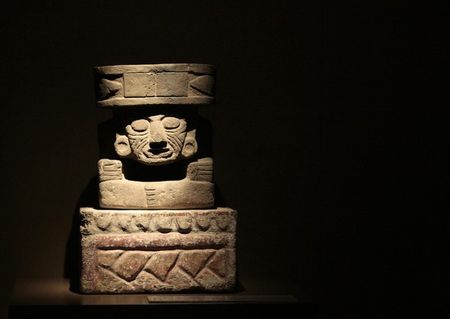“Teotihuacan, City of the Gods” @ the National Institute of Anthropology and History, Mexico
Aspect of “Disc of Death”, one of the pieces included in the exhibition “Teotihuacan: City of Gods” which opens this week at the National Museum of Anthropology in Mexico City. Photo: EFE/ Mario Guzmán
MEXICO CITY.- From May 29th 2009 to the end of August 2009, the National Museum of Anthropology (MNA) will show the great exhibition “Teotihuacan, City of Gods”, integrated by 435 items from the Prehispanic city, the largest in the world during its age (150 BC – 650 AD).
The National Institute of Anthropology and History (INAH) show will be displayed in an exhibition space measuring 3,500 square meters at the MNA.
Felipe Solis Olguin, who died recently, designed the curatorial proposal. He once explained it represented the intention of INAH to share with the national and international public the richness of Teotihuacan findings, within the frame of INAH's 70th anniversary.
Patricia Real, museographer and director of INAH Museums network, informed in a press conference that the show gravitates around quotidian life at the city, represented by replicas of patios and halls, which can be circulated by the public.
Other replicas exhibited are those found between 1998 and 2004, as part of the Moon Pyramid Project; humans and animals ritually sacrificed were found at the monument.
Archaeologist Miguel Baez declared that this exhibition is important because it offers a broad panorama about the Mesoamerican city, which was “a pole of attraction due to its commercial and military force, and a collegiate government, where the institution, not the ruler, was highlighted”.
35 figures that represent common inhabitants are displayed; the color of their garments, headdresses that distinguished the different social classes, and the way they used their hair can be appreciated.
Material found in the early 20th century by Leopoldo Batres is exhibited, as well as the most recent discoveries located at Xalla Palace, to the north of the Sun Pyramid.
The exhibition complemented with multimedia effects is the result of investigations made since 17th century, by Carlos de Sigüenza y Gongora until the 21st century, conducted by INAH researchers.
“Teotihuacan, City of the Gods” will later visit different European cities: Quai Branly Museum, in Paris, France; Rietberg Museum, in Zurich, Switzerland, and Martin Gropius Bau, in Berlin, Germany, as well as Spain, Italy, Denmark and Sweden between 2011 and 2012.
A stone sculpture of a man from the Classical Period (photo Reuters)
A ceramic piece from the Classical Period.
A ceramic piece from the Classical Period.
A ceramic piece from the Classical Period.
A pre-Hispanic piece called The Great Jaguar of Xalla. Photo Reuters May 21, 2009.
Displayed as part of the "Teotihuacan, City of Gods" exhibition in Mexico City's anthropology museum May 21, 2009. The figure, which was recovered 10 years ago in the complex called Xalla, was fashioned after a wall of the principal building of Xalla. Its head has a star, which represents Venus, and feathers like those worn by the city's warriors.
A pre-Hispanic piece possibly representing a woman, associated with the cult of maize. Photo Reuters May 21, 2009.
Displayed as part of the "Teotihuacan, City of Gods" exhibition in Mexico City's anthropology museum May 21, 2009. The figure has ear spools made of shells.
A pre-Hispanic piece called Old God of Fire. Photo Reuters May 21, 2009.
Displayed as part of the "Teotihuacan, City of Gods" exhibition in Mexico City's anthropology museum May 21, 2009. The top part represents a deity associated with the house and fire, while at the bottom is a domestic altar. In the head of the deity there is a censer where coal and incense were burnt during ceremonies.
A pre-Hispanic piece called Huehueteotl. Photo Reuters May 21, 2009.
Displayed as part of the "Teotihuacan, City of Gods" exhibition in Mexico City's anthropology museum May 21, 2009. Huehueteotl, the old god of fire, represents the relationship of Teotihuacan with the Gulf of Mexico Coast.
A prehispanic piece belonging to the exhibition Teotihuacan, City of Gods, is seen at the National Museum of Anthropology in Mexico City, Photo Reuters May 21, 2009.
A prehispanic piece belonging to the exhibition Teotihuacan, City of Gods, is seen at the National Museum of Anthropology in Mexico City, Thursday, May 21, 2009. Photo Reuters May 21, 2009.
Pre-Hispanic pieces symbolising governors of the city of Teotihuacan. Photo Reuters May 21, 2009.
The discs on the head represent power and prestige.
A pre-Hispanic piece called Turkey. Photo Reuters May 21, 2009.
In the workshops of Teotihuacan there were artisans that created visions of mythical animals, such as this representation of a turkey. It has seashells around its neck and shell ornaments on the head, while its eyes are made of greenstone.
A pre-Hispanic piece called Host Figure (L). Photo Reuters May 21, 2009.
The piece was found in the Mayan area. Inside lie figurines and jade objects, representing Teotihuacan culture.
A pre-Hispanic anthropomorphic figure (R). Photo Reuters May 21, 2009.
Constituting a ritual offering, the knives represent snakes that moved towards the anthropomorphic figure.
A prehispanic piece belonging to the exhibition Teotihuacan, City of Gods, is seen at the National Museum of Anthropology in Mexico City. Photo Reuters May 21, 2009.
And now, some pieces displayed at the Fundidora Park in Monterrey as part of the Mexican archaeological exhibition of the ancient city of Teotihuacan i September 19, 2008. The exhibition "Teotihuacan : City of the Gods" is the biggest of its kind with more than 400 pieces from different museums and collections.

/https%3A%2F%2Fprofilepics.canalblog.com%2Fprofilepics%2F1%2F0%2F100183.jpg)
/https%3A%2F%2Fstorage.canalblog.com%2F03%2F02%2F119589%2F96711876_o.jpg)
/https%3A%2F%2Fstorage.canalblog.com%2F11%2F31%2F119589%2F94773502_o.jpg)
/https%3A%2F%2Fstorage.canalblog.com%2F20%2F83%2F119589%2F94772815_o.jpg)
/https%3A%2F%2Fstorage.canalblog.com%2F26%2F72%2F119589%2F75604929_o.jpg)
/https%3A%2F%2Fstorage.canalblog.com%2F59%2F60%2F119589%2F26458628_o.jpg)




















/http%3A%2F%2Fstorage.canalblog.com%2F24%2F26%2F119589%2F117560837_o.jpg)
/http%3A%2F%2Fstorage.canalblog.com%2F55%2F54%2F577050%2F39873381_p.jpg)
/http%3A%2F%2Fstorage.canalblog.com%2F33%2F06%2F119589%2F34172173_o.jpg)
/image%2F1371349%2F20240423%2Fob_b2fe42_telechargement-9.jpg)